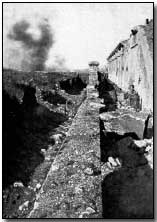Primary Documents - German Account of the End of the Battle of Verdun, October-December 1916
 Reproduced below is a contemporary
summary of the final fighting at the
Battle of Verdun from October 1916 onwards.
Reproduced below is a contemporary
summary of the final fighting at the
Battle of Verdun from October 1916 onwards.
Written by the semi-official German historian Colonel Frobenius his account noted the significant loss - from German into French hands - of the forts of Douaumont and Vaux.
Click here to read Falkenhayn's justification for the offensive. Click here to read Crown Prince Wilhelm's summary of the battle. Click here to read Wilhelm's summary of its abandonment. Click here to read von Hindenburg's decision to call off the offensive. Click here to read Erich Ludendorff's dismissive view of the battle. Click here to read Joseph Joffre's August 1916 summary of the battle. Click here to read British newspaper baron Lord Northcliffe's despatch during the early days of the battle.
Click here to read a French memoir of the German attack on Le Mort Homme in May 1916. Click here for a memoir of the struggle for Fort Douaumont the same month. Click here for a memoir of the German assault upon Fort Vaux in June 1916. Click here to read General Millerand's official account of the see-saw fighting at Thiaumont in July and August 1916. Click here to read a French staff officer's account of the recapture of Fort Douaumont in October 1916.
Colonel Frobenius on the End of the Battle of Verdun
In the Battle of the Somme the English and the French indeed succeeded as far as their avowed object of relieving the French defenders of Verdun was concerned.
The Germans, in order successfully to resist the onslaughts at the Somme, were compelled to draw heavily upon their artillery before Verdun, thus enabling the French there to proceed to counter-attacks.
It was not unknown to the Germans that the defenders were preparing to recapture forts Vaux and Douaumont. The artillery preparation for the attack began on October 21st, the attack being directed, on October 24th, from the lines on the heights of Haudromont over the crests at Fleury, and from Vaux-Chapitre toward Damloup.
Against the troops stationed within the area Douaumont-Vaux, consisting of 28 battalions and 10 reserve battalions, together with 130 batteries, the French launched three divisions with an additional infantry regiment joined to each wing.
The attack of the troops, which had been long and carefully detailed, succeeded. On the 26th the German position, including the third line, was in the hands of the French. Fort Douaumont, which, in consequence of the bombardment was afire and had become untenable, had already been evacuated on the evening of the 23rd. Only Fort Vaux held out until November 2nd.
A cessation of the combats, now supervened, the Germans meanwhile occupying positions farther back, their operations remaining unmolested by the enemy.
The French wished to renew the attack with the utmost rapidity, yet the artillery fire accompanying the attack of the 24th had so devastated the region to be traversed that it was found necessary first to make the roads leading to the newly won positions passable.
The transportation of the heavy, artillery was not completed therefore until December 11ith, so that the preparation for the new attack could not begin before that day. The goal was the line Bezonvaux Forest from Courieres Farmhouse over Chambrettes, Louvemont, Vacherauville. Consequently the attack had to be made in the form of a wide diversion to the left.
Four divisions began the attack on December 15th, and, after several bloody encounters, succeeded, on the 18th, in attaining their goal. With this second undeniable success the defenders of Verdun remained content for the time. As the Germans also had no motive for continuing the attacks, the heavier combats here ceased for the winter.
The fighting activities were not resumed until March 1917.
Source: Source Records of the Great War, Vol. V, ed. Charles F. Horne, National Alumni 1923
A 'Baby's Head' was a meat pudding which comprised part of the British Army field ration.
- Did you know?
